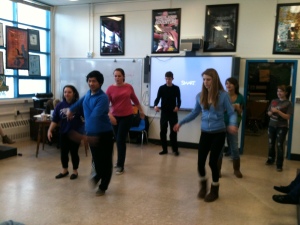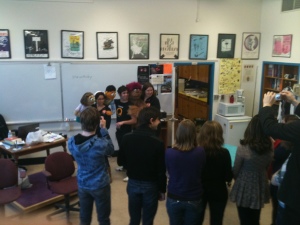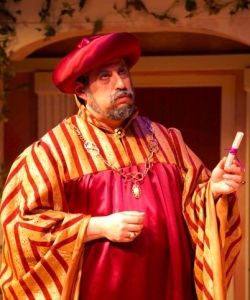I have been in the business of education for over 20 years. I have seen fads in education come and go. While most of my experience has been with high school aged students, I have worked with grade school aged students during most summers of the last decade as well as college students and mature adults in numerous workshops and productions. Through research, experimentation and two decades of experience, I have come to develop a teaching philosophy that I know is true.
You Can’t Learn much from a Textbook
First, nobody really learns  anything out of a book alone. We simply are not built that way. Of course a student can read a text, memorize something for the exam and do well on the assessment. But that quickly fades with time, and memorizing is not the same thing as “knowing.” The standard educational system, whether it is University or Public School, is predicated on a mass production model where students “learn” by sitting in nice straight rows listening to a teacher lecture, or worse, read out of a textbook on their own. But when countless experts in human behavior and brain research, like John Medina in “Brain Rules,” say this is the worst method of learning, it begs the question of why we continue to do it?
anything out of a book alone. We simply are not built that way. Of course a student can read a text, memorize something for the exam and do well on the assessment. But that quickly fades with time, and memorizing is not the same thing as “knowing.” The standard educational system, whether it is University or Public School, is predicated on a mass production model where students “learn” by sitting in nice straight rows listening to a teacher lecture, or worse, read out of a textbook on their own. But when countless experts in human behavior and brain research, like John Medina in “Brain Rules,” say this is the worst method of learning, it begs the question of why we continue to do it?
4 Principles of Engaged Learning
Instead, I have adopted several principles which I use on a daily basis that have proven successful:
1. Students must move to learn. What this means is that sitting in chairs listening to soporific lecture is replaced by active engaged participation. Students must be up out of seats whenever possible DOING. This is true in the history class, the literature class and even the math class, not just in acting.
2. The teacher must engage as many senses as possible. This includes hearing, touch, and yes, even taste. The more engaged the senses are, the more engaged the brain is, and all the brain research tells us that the more areas of the brain that are lit up, the better students learn. This is just as true of college students as it is of geriatric adults.
3. Story Telling and other forms of “theatre” are the best methods of conveying virtually any area of knowledge. We know this historically from the epic sagas used to teach when literacy was almost non-existent. It is still true today, even in the age of the Internet.
4. All knowledge is connected. This has been the basis for the School Through The Arts program I started at West Anchorage High School almost 20 years ago. Knowledge does not come in separate compartments. It need not be taught that way. A theatre history class, for example, must and should touch on aspects of acting, lighting, literacy, art, architecture, politics, engineering, chemistry, etc., not just on Thespis standing out of the Greek Chorus. Students learn best when they connect something unknown to something known. The more we tap into the synergy of a knowledge web, instead of information compartments, the better opportunity we have to foster learning.
Immersive Education
Second, immersion is the best way to address all the senses at once. It is one thing to read about the Rosetta Stone in a book and see a picture of it. It is another thing entirely to stand in front of it, inch es from touching it. How better can one understand Wm. Shakespeare’s plays than to go through the Birthplace, walk to Trinity Church to see his grave, then, later that evening, see a show in the Globe? People learn best by drowning in the experience, not listening to lecture.
es from touching it. How better can one understand Wm. Shakespeare’s plays than to go through the Birthplace, walk to Trinity Church to see his grave, then, later that evening, see a show in the Globe? People learn best by drowning in the experience, not listening to lecture.
Of course this is expensive, but it is also invaluable. And there is always a way to find money. Always. In 20 years of teaching, I have taken students to Broadway twice, Ashland, Scotland five times, England and Paris. That’s ten theatre based trips in 20 years, not counting a half dozen more trips across the United States for national speech competitions. If this can be done at the high school level it can certainly be done at the collegiate level.
Set High Standards
Third, the “dumbing” down of content may create a temporary jump in the rate of “success” if one measures that success in grades or test scores. But if the goal is to turn out students who know their craft, there can be no apology made for high standards. Nor can one negate the positive effects one gains from temporary set back or perceived failure. These are learning opportunities. Teachers need to set expectations high. My experience has been that most often, students will rise to those high levels of expectation. But for those that do not, the true educator is there to mentor the student through a short term failure to ultimate long term success.
Teach Through Example
Finally, I firmly believe in the principle of “See One, Do One, Teach One.” We typically expect students only to accomplish the second goal; “do one.” But how are they to prove they know the material unless they can teach it to someone else? This is how you build a program, how you multiply the presence of the educator and how you make inroads into the community. It is not something that can not be accomplished with paper and pencil tests. When your students know how to do the task, they multiply the presence of the instructor by teaching others less able; your program grows. When they have proven their mastery of a thing, they can teach others in the community, creating an invaluable link between “town” and “gown.”
you multiply the presence of the educator and how you make inroads into the community. It is not something that can not be accomplished with paper and pencil tests. When your students know how to do the task, they multiply the presence of the instructor by teaching others less able; your program grows. When they have proven their mastery of a thing, they can teach others in the community, creating an invaluable link between “town” and “gown.”
Further, how can a student “see one” unless s/he observes the teacher doing it? Theatre is about doing, not reading about other people doing. A student must be able to see that the instructor is capable of doing that which s/he teaches, or else fall prey to the old saw, “Those that can, do, those that can’t, teach.” How can a teacher realistically teach a class on auditioning without auditioning from time to time? I make it a practice to do these things, and some of them maybe not so well, but I cannot just talk the talk, I have to also walk the walk, or the student perceives the instructor is no more useful than the textbook.
A philosophy of throwing out the textbook as the sole source of education, using principles of engaged learning, immersing students in the content and illustrating concepts through example has proven to be a successful paradigm. My students are prepared, enjoy learning and develop strategies to become self-learners and problem solvers.
